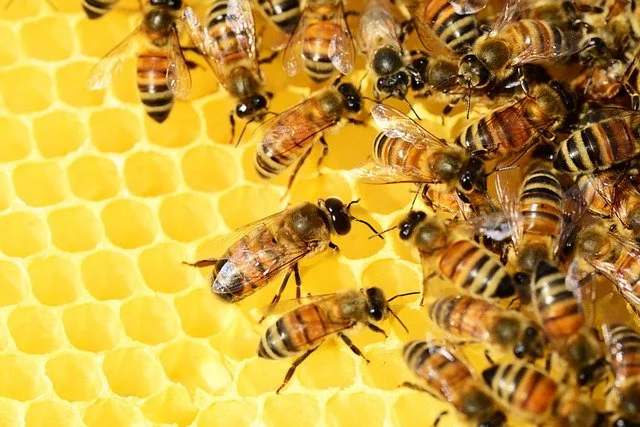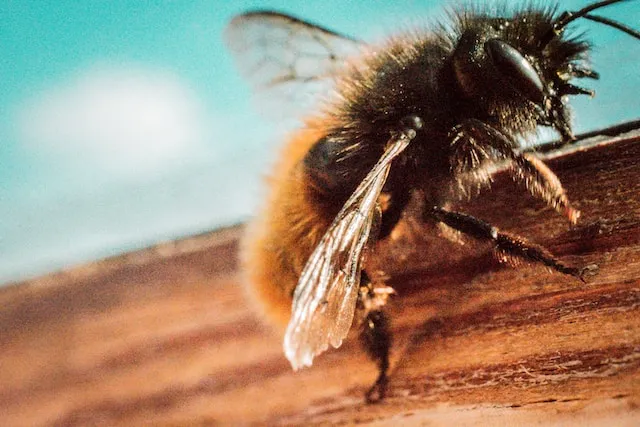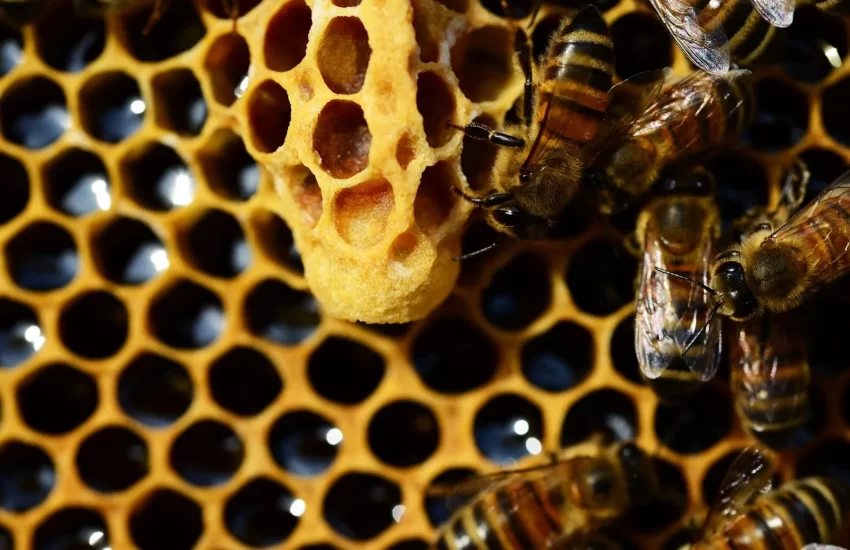What Do Bees Eat? Do bees eat Honey? Do queen Bees eat Honey?
Like humans, bees require nourishment to sustain their life. We mostly see these hard-working creatures foraging for food resources. Amazingly, they can fly up to 5 miles to ensure their colonies are well fed. The diets in a honey bee colony depend on age and task. In addition to food, they also require water for sustenance.
What do bees eat?
Honey bees feed on two types of food that they get from flowers: nectar and pollen.
Pollen is a powdery substance produced by the male part of a flowering plant(anther) and contains male elements for reproduction. It is among the richest and purest natural foods that are known to man. It provides the honey bees with most of their nutritional requirements ( proteins, vitamins, enzymes, minerals, and lipids). Nectar is a sugary-filled liquid produced by flower nectaries of plants to attract pollinators. It acts as a primary carbohydrate (energy) source for the bees.
Similar Articles you may like to read –
Approximately how many flowers must bees visit to produce one pound of honey?
30 Best Flowers That Attract Bees, Butterflies, and Pollinators to Garden
What colors should you avoid around bees?
What Color Bees Cannot Recognize?
Are bees active at night?
How do bees collect pollen?
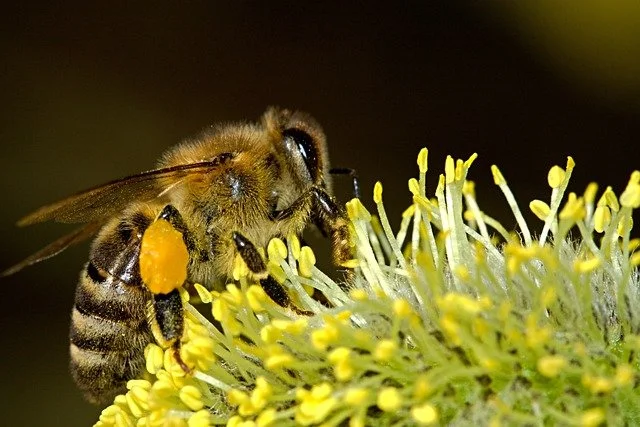
Pollen sticks on the bee’s hairy body as they forage from one flower to the other. Once their bodies are covered with pollen, they use their front legs to remove it and cover it with regurgitated nectar to form pollen pellets. They store it in pollen baskets on their hind legs and ferry it to the hive. Its color ranges from yellow, and orange, to bluish purple. These are seen as bright yellow or bluish balls hanging from the pollen sacs.
How do bees store pollen in the hive?
The house bees convert pollen to bee bread: a mixture of honey, pollen, regurgitated nectar, and glandular secretions enzymes from their saliva. It has lower ph and less starch than fresh pollen.
Surprisingly the nutritional value of bee bread is higher than that of fresh pollen due to the fermentation process involving lactic acid bacteria from the honey bee stomach. In its original form, pollen is hard to digest, especially for the young brood.
Its fermented form is easy to digest and has an increased shelf life. The fermentation process of pollen into bee bread reduces its moisture content, prevents mold formation, and protects the product for future use. It is vital in summer and spring when brood rearing is optimum. Bee bread is stored between the brood and honey cells in the hive and sealed with a honey drop. It is consumed at a higher rate than honey, especially in the productive months. Unlike honey, its shelf life is shorter(about 1 year).
Towards winter, the queen stops laying an egg; hence the need for protein in the colony reduces. Protein content from pollen varies with plants. Honey bees require proteins from different sources to meet their needs.
Bee pollen is also harvested alongside honey as human food: it is one of the most valued food supplements due its numerous health benefits. You may also read our article on “health benefits of eating pollen; Is bee pollen good for allergies?”
How do bees get nectar from flowers?
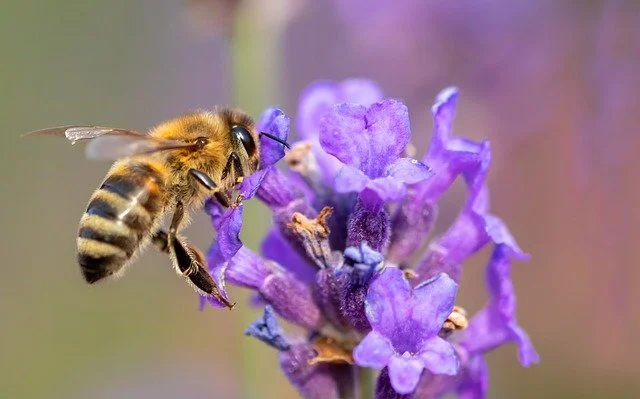
Honeybees have an elongated tongue known as proboscis to draw the nectar from the flower nectaries. It is then stored in a honey crop or honey stomach. When it is full, they return to the hive, where they regurgitate it to the house bees.
What do bees do with nectar?
Nectar contains about 80% water, so the bees cannot store it in this state since it will ferment to alcohol. They convert it into honey which has low moisture content and high sugar content. It has a long shelf life and can be stored for years. You may also check a guide on” What is bees nectar? and the role of bee’s nectar?” Check this for more information about nectar.
Honey mostly contains carbohydrates with trace amounts of minerals and sugars. They preserve the honey in combs in large quantities. The super-skilled and intelligent creatures know that a time will come when the cold weather will not allow them to forage. They will use honey for survival.
How do Bees make honey?
The process starts with forager bees collecting nectar which they store in the honey stomach. In the honey crop, they add enzymes invertase and glucose oxidase to the nectar. Invertase converts the complex sugar in nectar- sucrose into glucose and fructose. Once the honey crop is full, the foragers ferret it to the nest, regurgitate the nectar to the house bees, who process it further.
It is chewed and passed from one house bee to the other for about 30 minutes. In this process the enzymes present in bee saliva changes its chemical composition and Ph. They then spread it on honey combs and dehydrate it by fanning their wings to attain a moisture content of 18-20%. The product is sealed with a thin layer of beeswax to avoid contamination.
Do bees eat honey?
Honey bees eat honey. Amazingly, all bee species that make honey feed on it. Here are some of the reasons why bees eat honey. I have written an article on “ What do bees do with honey?” Check this for more information on honey.
For Energy Supply
Worker bees spend the better part of their lives foraging. In a single day, they can make up to 15 foraging trips to gather nectar and pollen and ferry the loads back to the hive. These trips demand a lot of energy. Honey provides the bees with the energy they require. Foragers can also obtain nutrients directly from nectar while foraging.
To Generate Heat
The workers metabolize honey to produce heat. This is crucial in controlling the hive’s temperature.
Making Beeswax
Young worker bees consume considerable amounts of honey to produce honeycomb. They secret wax from wax glands situated on their abdomens which they use to construct comb. They use comb to store honey, seal the honeycombs and make brood cells. Surprisingly, they consume about 8kg of honey to produce 1kg of wax.
In winter
In winter, the temperatures are too cold to forage. The bees depend on the stores of honey in the honeycombs to stay alive. They also use the energy to vibrate their wing muscles to generate heat.
When Swarming
Bees reproduce naturally through swarming when they run out of space in the hive. In preparation for swarming, they consume abundant honey to keep them going for a couple of days.
To Make Royal Jelly and Beebread
Nurse bees consume large quantities of honey and pollen to produce royal jelly and bee bread.
What do honey bee larvae feed on?
The majority of honey bee larvae are fed with bee bread. They are regularly inspected and sufficiently fed by the nurse bees. However, those destined to be future queens are fed exclusively with royal jelly. This is a whitish substance secreted by young female workers from hypopharyngeal glands situated on their heads. It contains fertility stimulants, B vitamins, dietary supplements, and other rich substances. Larvae destined to be drones or worker bees are fed with this rich substance for the first three days of their lives. Due to the rich food supplied in its developmental stage, a queen bee can live up to five years and lay up to 2000 eggs daily in the peak seasons.
Young worker bees consume large portions of bee bread or pollen in their first days of their adulthood to complete development. This enhances them to nurse the larvae and secrete royal jelly for about the next 15 days of their lives. They will also help to build comb, after which they join other foragers in fieldwork. After 15 days, they lose the ability to produce proteolytic enzymes required in pollen digestion. At this stage, they survive on honey and nectar.
What does the queen bee eat? Does she eat honey?
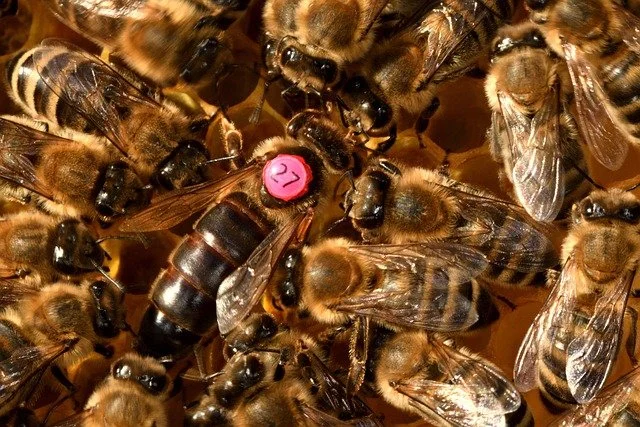
A queen bee is entitled to royal treatment from the workers. She consumes royal jelly exclusively in the developmental stage. The rich royal jelly enhances the queen larvae to grow rapidly and attains twice the size of a normal worker bee. It helps her to fully develop her ovaries to be reproductive. A mature queen bee is fed by the workers directly. She is usually surrounded by attendants who feed her with a predigested blend of honey. She can also eat independently or even from honey supplies in the hive when hungry. They feed almost constantly as they need the energy to be able to remain productive.
What do drone bees eat?
Drones are male bees and their role is to mate with the queen bee. Amazingly, adult drones do not feed themselves. They are supplied with a mixture of glandular secretions, honey, and pollen by the nurse bees. They are evicted from the colony in late fall to minimize the usage of the food reserves. Surprisingly, they are bigger than worker bees and consume three times more. Again, in winter, there is no brood rearing in winter and their services are not needed.
Is it right for beekeepers to take some honey?
Honey bees make more honey than they can use in most cases. You are responsible as a beekeeper for ensuring the colony has enough for winter while you are harvesting. Some beekeepers, however, take a significant amount of honey and substitute it with sugar syrup.
Supplemental Feeding
Honey bees depend on supplemental feeding in times of food scarcity. Although not the ideal food for them, it is necessary for their survival.
Nectar Supplements
Beekeepers feed their colonies with sugar syrup in times of shortage or if the bees have insufficient food reserves for the cold season. However, this should not be their daily food. It is meant to help the bees to survive until natural food resources become available. The ideal supplement to nectar is cane sugar. Beekeepers should avoid molasses or brown sugar. High fructose corn syrup may also cause digestive problems such as dysentery to the bees. Sugar can be presented to the bees in form of dry sugar, syrup (made with sugar and water), or bee candy. Bee candy or fondant is preferable in winter. A thin sugar syrup (1:1) is fed in spring and summer, while a thick sugar syrup (2:1) is ideal in fall as bees head to winter. While they can store honey, they cannot make honey from sugar since it lacks all nectar properties. Bees also collect fruit juices from over-ripe fruits and plant exudates in times of shortage. They love plums, pears, grapes, and apples.
Pollen Supplements
To enhance productivity, they also feed the bees with pollen patties. Pollen supplements do not contain pollen but have ingredients that supply protein and other minerals like natural pollen. Pollen supplements may contain brewers’ yeast, soy flour, dry milk, and essential oils. They also collect honeydew secreted by insects such as aphids. In place of pollen, they can collect plant spores though they are a poor substitute for pollen.
More articles you may like to read –
Interesting Facts About Honey Bees
What do bees do with pollen?
Types of Honey Bees, Honey Bee Stocks
Do Bees Recognize Their Owners?
Do Honey Bees Stay In The Same Nest Every Year?
Do Honey bees need water to survive?
Water is an essential component of the honey bee diet. The foragers collect water as they do nectar or pollen. They use it to maintain a conducive temperature and humidity within the beehive. ( evaporative cooling) The house bees also use it to dilute the thick honey to add it to brood food. Beekeepers should ensure a clean water source for the bees near the hive. Bees usually prefer water with some salts. E.g., a swimming pool. In winter, honey bees usually have ample water from condensation over the inner cover.
FAQs
How do honey bees eat?
Honey bees feed through two types of mouthparts. These include mandibles for cutting and chewing and an elongated tongue known as proboscis for sucking up fluids. The queen bee has the same mouthparts as the worker bee and can slow feed in the same way.
What do bees eat when they cannot access nectar?
On top of keeping honey stores to use on days when the weather is not favorable, honey bees will also feed on over-ripe fruits. When food resources are scarce, beekeepers usually provide sugar syrup.

